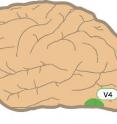Why is an object's size perceived the same regardless of changes in distance?
A group of researchers at Osaka University found that neurons in the monkey visual cortical area V4*1, one of the areas in the visual cortex, calculate the size of an object based on information on its retinal image size and the distance from the object. The neural mechanism for the perceptual phenomenon in which size was perceived to be stable even if the distance from the object changed (known as size constancy) was unknown. Many neurons in the visual cortex change their activity according to the size of visual stimulus. It was believed that neurons responded to the size of the image formed on the eye (retinal image); however, size constancy (Figure 1) cannot be achieved by such cells alone.
Ichiro Fujita and Shingo Tanaka, then student in the doctoral course of Graduate School of Frontier Biosciences, Osaka University, examined if there were cells that express not the retinal image size, but the size of the object itself. The group analyzed neuron activity in the monkey's visual cortical area V4 (in Figure 2) and found that cells in this area integrated information about retinal image size and the distance from the object to calculate the size of the object.
When an object is far away, its retinal image size becomes small, and when the object is near, its retinal image size becomes big. If neurons respond to the same retinal image size, even if the distance from the object changes, they are supposed to react to retinal image size. In contrast, if neurons convey information about object size, they are expected to react to the small retinal image when the object is far away and to react to the big retinal image when the object is near. Fujita and Tanaka found that most cells in the visual cortical area V4 reacted well to small stimuli when the stimuli were presented far away and reacted to big stimuli when stimuli were near. This is the property of a cell that expresses object size should have. This group's experiment verified that cells in the visual cortical area V4 do not react to the retinal image size but to the size of the object. These cells are thought to contribute to constancy of the perceived size regardless of changes in distance by conveying certain information about the object's size.
This group's achievements clarified the neural basis of size constancy and are expected to be helpful in improving 3D image-recognition techniques and understanding causes of diseases manifesting size perception disorder.
The results were published in the Journal of Neuroscience website on August 26, 2015.
Source: Osaka University
Articles on the same topic
- Monkeys and humans see visual illusions in similar way, study findsMon, 28 Sep 2015, 15:03:26 UTC
Other sources
- Monkeys and humans see visual illusions in similar way, study findsfrom Science BlogMon, 28 Sep 2015, 15:31:15 UTC
- Why is an object’s size perceived the same regardless of changes in distance? Neural mechanism of size constancy clarifiedfrom Science DailyMon, 28 Sep 2015, 15:00:12 UTC
- Monkeys and Humans See Visual Illusions in Similar Way, Study Findsfrom Newswise - ScinewsMon, 28 Sep 2015, 14:30:26 UTC
- Monkeys and Humans See Optical Illusions in Similar Wayfrom Science DailyMon, 28 Sep 2015, 14:00:07 UTC
- Monkeys and humans see visual illusions in similar way, study findsfrom PhysorgMon, 28 Sep 2015, 13:00:44 UTC

